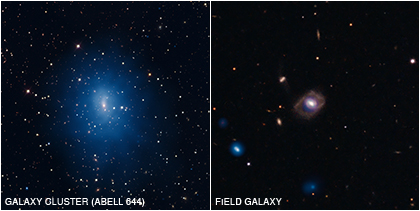How Often do Giant Black Holes Become Hyperactive?

This two-panel graphic contains two composite images of galaxies used in a recent study of supermassive black holes. In each of the galaxies, data from NASA's Chandra X-ray Observatory are blue, and optical data from the Sloan Digital Sky survey are shown in red, yellow and white. The galaxy on the left, Abell 644, is in the center of a galaxy cluster that lies about 920 million light years from Earth. On the right is an isolated, or "field," galaxy named SDSS J1021+1312, which is located about 1.1 billion light years away. At the center of both of these galaxies is a growing supermassive black hole, called an active galactic nucleus (AGN) by astronomers, which is pulling in large quantities of gas.
http://www.chandra.harvard.edu/photo/2010/2gal/
-Megan Watzke
Category:
- Log in to post comments
